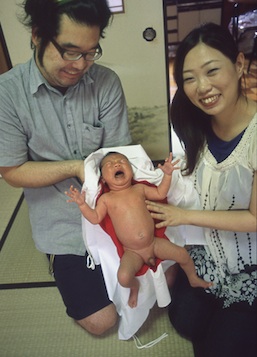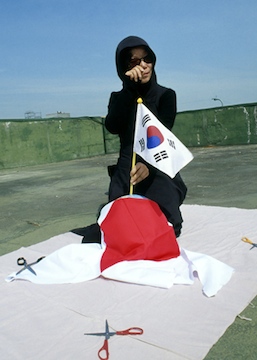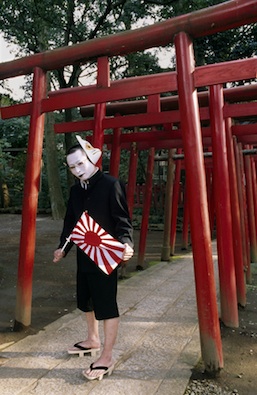The Hinomaru: A Question of Identity
Quite the force to be reckoned with, Mao Ishikawa is a photographer who may be considered an outsider on at least two counts. For one she is female, but maybe even more significantly she is also Okinawan. Born in 1953, Ishikawa grew up in an environment separate from Japan but as an adult later experienced the ambivalent restoration of Okinawa back to Japanese sovereignty first-hand, a fact that surely informed the conception and execution of the body of work selectively on show in her current exhibition, “Here’s What the Japanese Flag Means to Me”, at the Zen Foto Gallery, Roppongi.
Just over a dozen medium-sized photographs framed and displayed in a simple format, this show delivers an overwhelming emotional blow. Immediately striking is the intimate, corporeal, and in some instances visceral, nature of the portraits. Accompanied below by short statements from each of the subjects, the initial aesthetic assault on the senses only takes hold more deeply as you read and continue round the show. From the outset it is clear that there are many more challenging and problematic images on show than there are ones that produce a calming or reassuring effect.
Presented with the hinomaru flag – though this is not exclusively what appears in the images – the individuals captured in the portraits were asked to use this symbol in a way that “express[ed] their feelings about Japan and the Japanese.” The history of the hinomaru (or ‘sun mark’, known formally as the nisshouki) flag is rather tumultuous, and along with the kimigayo (national anthem), the nature of its nationalistic symbolism remains in aggressive dispute. Whilst it has widely been recognised as the official flag of Japan since the Meiji era, the hinomaru wasn’t legally confirmed until a much-contested act was passed in 1999. Schools are one of the arenas where related dissension to the flag is most visible, and the effects can be seen of laws created subsequently in order to control the behaviour of Japanese citizens in relation to it can be seen. However, though this ‘official’ or public narrative surrounding the hinomaru is referenced by the inclusion of a portrait of a group of right-wing nationalists, this is far from the only dimension explored by Ishikawa.


In a large proportion of the photographs, the flag is presented in conjunction with, or at a disjunction to, the body. The flag pertains so closely to the skin in some images that it starts to take on cutaneous properties, almost becoming a part of the connective tissue. As it starts to form a kind of second skin, however, it displays dualistic properties; it apparently has the potentiality to comfort and to protect or, alternatively, to inhibit and guilefully conceal. The presence of the individual subjects and their ambiguous relationships with the flag take on their most powerful manifestations in the few images of participants with physical afflictions. A one-legged Hiroshima survivor holds the hinomaru in front of her, the viewer prevented from seeing to what extent her leg is missing, the flag acting as a kind of auxiliary body, whilst a twenty-six-year old graduate who was left with necrosis in her breast after a case of medical malpractice is seen partially standing upon a cut up hinomaru laid out on the ground in two symmetrical halves. She also has a version of the flag sprayed onto her deformed left breast. According to their testimonies, both of these women wish for peace.

Though there is no overarching comment or ruling pushed by Ishikawa in the way that she presents this work, she firmly asserts her own exclusive attitude by way of a self-portrait that features in the show. Fantastically black in its humour, it shows her seemingly nude behind the hinomaru that she holds up. In the centre of the flag, there is a strange perforation that only really makes sense once you read the text mounted below: “In 2001, I developed rectal cancer. My anus was closed, a hole was made… It looks like a Rising-Sun flag [sic], which made me laugh. I showed my artificial anus, through the hole I made, in the middle of the Rising-Sun flag [sic]. It is an important partner installed so that I can keep on living.” By taking up the flag in this way, Ishikawa could almost be seen to be desecrating the hinomaru and totally debasing it. This may be true, but to read this image only in this manner is surely an oversimplification. In the introduction to the accompanying photo book she proudly expounds, “I am not a Japanese, but an Okinawan. And I will live proudly as an Okinawan forever.” It may be that though Ishikawa denies any essential Japanese identity, she accepts that her ongoing battle with this external identity has become an ingrained, if undesirable, part of her being.
Jessica Jane Howard
Jessica Jane Howard



